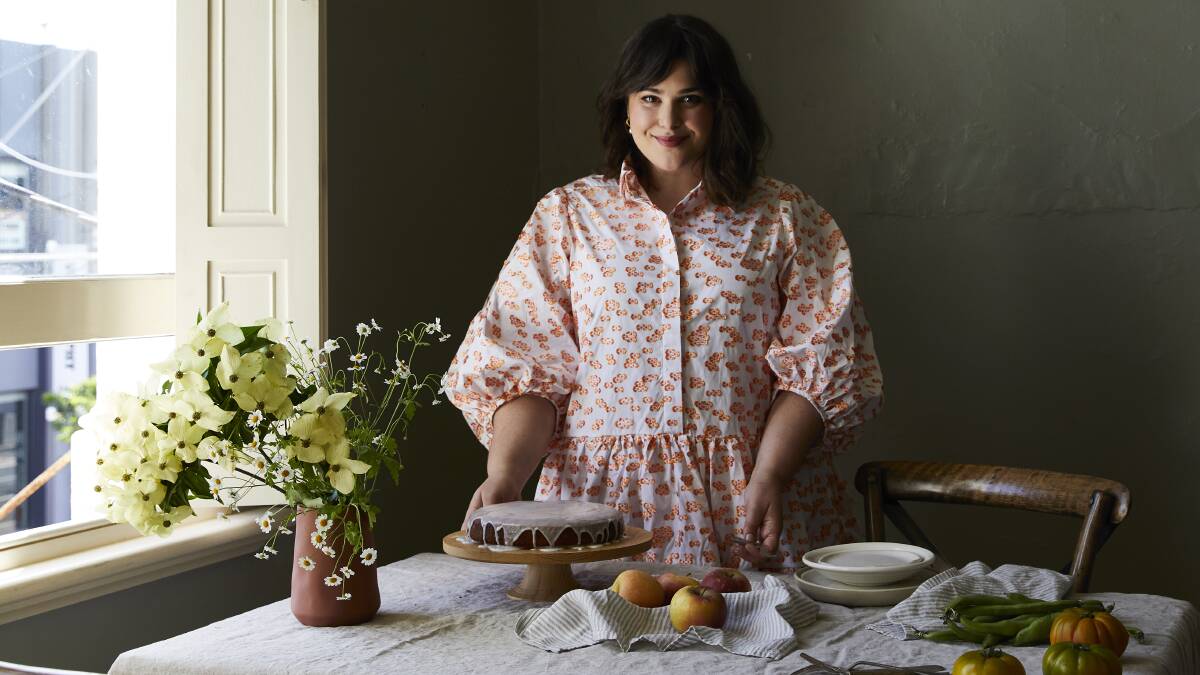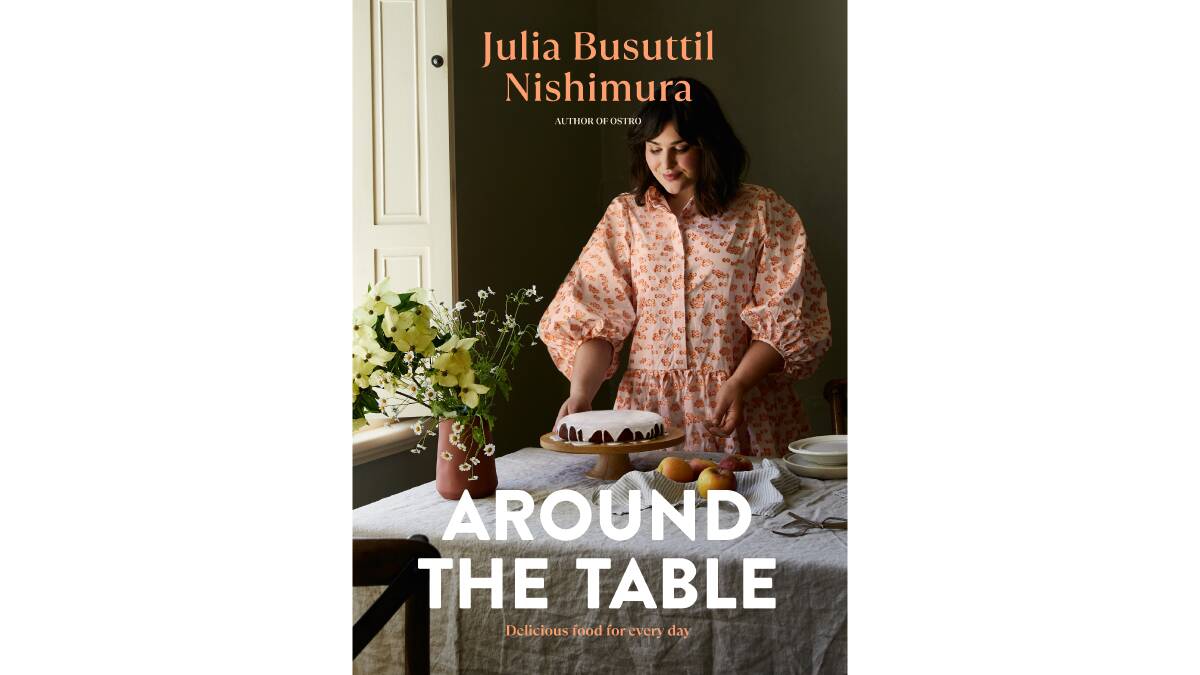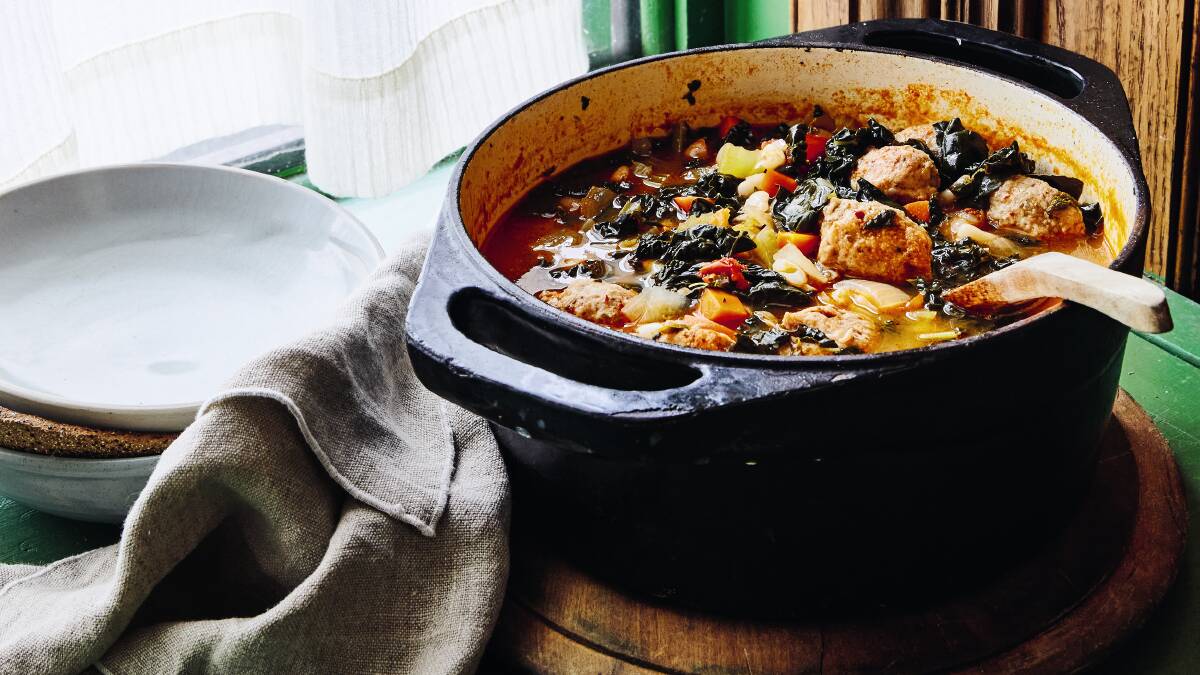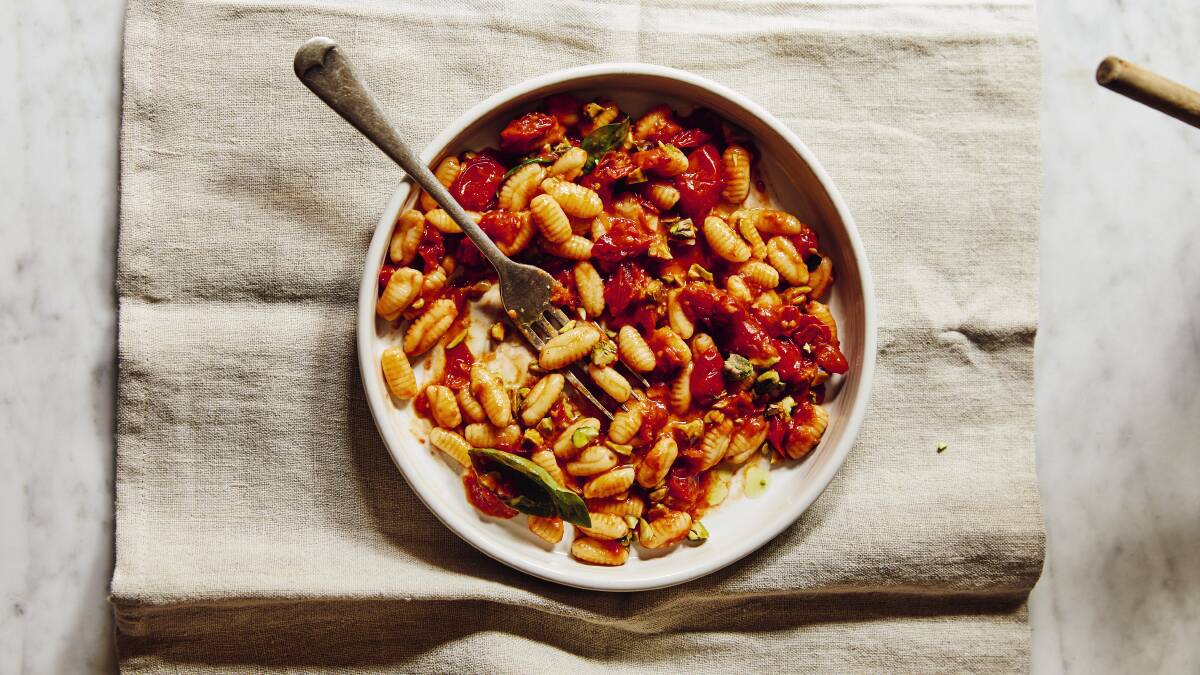
All of Julia Busuttil Nishimura's childhood memories centre around food. She can still remember waking up on a Sunday morning to the smell of onions cooking, or sitting on the back step with her grandmother podding broad beans.
"Food is so evocative and powerful and often is so connected to happy memories," she says.
"There is something about food memories being so sensory that they remain incredibly rich which is such an incredible thing."
Her latest book, Around the Table: Delicous food for every day, encapsulates how she thinks about food. The seasons underpin her choices at the market and in the kitchen. She is guided by mood, feelings and memories.

"My day usually revolves around what is for dinner," she says.
"Cooking is one of the greatest joys in life and so shopping and cooking is a real priority in my day. But I understand not everyone shares those sentiments.
"I think part of it is carving out a little extra time to shop well which sets you up in the kitchen for easy decision making and makes it more enjoyable.
"I think it's all about not overcomplicating things too. During the week I keep it incredibly simple and save the more time consuming or complicated things for the weekend. A quick pasta on a Wednesday night is incredibly satisfying. For me I never have a real plan though so I think it's just about finding what works for you."
The five things she always has in the kitchen are anchovies, tinned tomatoes, extra virgin olive oil, garlic and lemons. A typical Tuesday night dinner is something incredibly simple.
"Perhaps it's pasta using tinned tomatoes and maybe a few sausages to make a quick sauce, or a one-pan chicken dish with lemon and rosemary. We might make okonomiyaki or a simple quick braised fish and serve it with steamed greens and rice. Something easy, delicious and not too time consuming is key."
- Around the Table: Delicious food for every day, by Julia Busuttil Nishimura. Plum. $44.99.

Sausage, cannellini bean and cavolo nero soup
When the weather turns a little miserable, life is made immeasurably better by a steaming bowl of soup. It's when my pantry is used the most, utilising beans and pulses to add heartiness to soups and stews. While canned beans are more than fine, if I'm making a soup where beans are heavily featured, I really want to go to the eort of soaking and cooking them from dried. What you give in time, you reap in flavour, as the bean cooking water creates a wonderful base for the soup. Here, good sausages are also key - choose thick Italian-style ones. I like pork and fennel, but whatever you prefer will be suitable. If you don't have any tomatoes on hand, you can simply swap them for two or three whole tomatoes from a can.
Ingredients
- 3 tbsp extra-virgin olive oil, plus extra to serve
- 500g pork and fennel sausages, casings removed
- 1 onion, roughly chopped
- 2 celery stalks, roughly chopped
- 1 carrot, roughly chopped
- sea salt and black pepper
- 4 garlic cloves, roughly chopped
- 2 roma tomatoes, roughly chopped
- 2 marjoram or oregano sprigs
- 1 bunch of cavolo nero, ribs removed, leaves roughly chopped
- handful of parsley leaves, roughly chopped
- grated Parmigiano Reggiano, to serve
- chilli flakes, to serve
Beans:
- 200g dried cannellini beans, soaked in cold water overnight
- 2 fresh bay leaves
- 6 peppercorns
- 1 celery stalk, halved
- 4 parsley stalks
Method
1. To make the beans, drain and rinse them, then place in a large stockpot with the bay leaves, peppercorns, celery, parsley and three litres of water. Bring to the boil, then reduce to a simmer and cook for about 45 minutes, until the beans are tender. The cooking time will depend on the freshness of the beans, so begin testing them at the 30-35 minute mark and continue checking every 10 minutes until done.
2. When the beans are almost tender, begin the soup base. Warm the olive oil in a large saucepan over medium heat. Break off pieces of the sausage meat to form small meatballs and add them to the pan. Fry for four to five minutes, until golden on all sides. Remove the meatballs, then reduce the heat to medium-low and add the onion, celery and carrot with a pinch of salt and cook for 10 minutes until beginning to soften. Add the garlic and tomato along with the marjoram or oregano. Increase the heat to medium and cook for a few minutes until fragrant and the tomato has begun to collapse. Return the meatballs to the pan and stir so that everything is well coated.
3. Remove the celery and parsley stalks from the bean liquid and discard, then add the beans, along with the cooking liquid, to the soup base. Simmer the soup for 15-20 minutes, until thickened and the beans are very tender. Add the cavolo nero leaves and cook for 10-15 minutes. Remove the bay leaves and stir through the parsley. Season to taste and serve with grated Parmigiano Reggiano, a drizzle of extra-virgin olive oil and a sprinkling of chilli flakes.
Serves 4.

Cavatelli with roasted cherry tomatoes and pistachios
Making cavatelli from scratch is incredibly soothing, and when you get into a rhythm you will do it with ease. Use 320g dried cavatelli or another dried pasta, if you're short on time.
Ingredients
- 700g cherry tomatoes, halved
- 3 garlic cloves, roughly chopped
- sea salt
- 3 tbsp extra-virgin olive oil
- 70g shelled pistachios, roughly chopped
- basil leaves, to serve
Cavatelli:
- 400g finely ground semolina flour (semola rimacinata), plus extra if needed and for dusting
- fine salt
Method
1. To make the cavatelli, tip the semolina flour onto a clean work surface, add a pinch of salt and mix to combine. Create a well in the centre of the flour and pour in around 200ml of warm water, a little at a time. Using your hands, slowly bring the flour into the water in a circular motion, then mix with your hands until the dough begins to come together (a pastry scraper helps). The dough may seem shaggy, but it will come together as you knead it. If it seems very dry, you can sprinkle over some more water, but do this with caution as you want to end up with a rather firm dough. Knead well for 10 minutes, until the dough is smooth, adding a little more flour if the dough is sticky. Once the dough begins to look smooth, it is important that you clean your hands and work surface of any dry dough. This will stop the dough picking up flecks of dry dough as you knead it. Cover with an upturned bowl or plastic wrap and allow to rest at room temperature for at least 30 minutes.
2. Preheat the oven to 180C.
3. Working with a small amount of dough at a time, roll the dough into long ropes, about 5mm thick. Cut each rope into 1cm pieces and use your thumb, forefinger or a non-serrated knife to press and roll one piece at a time on a gnocchi board to create little ridged cavatelli. This can also be done on a flat surface to create smooth cavatelli. Place the cavatelli on a wooden board or tea towel that is generously dusted with semolina flour. Continue the process with the rest of the dough, arranging the cavatelli in a single layer.
4. Combine the tomatoes and garlic in a large bowl. Season well with sea salt and drizzle with the olive oil. Mix everything together, then tip onto a baking tray (lined with baking paper if you like). Transfer to the oven and roast for 30 minutes or until the tomatoes have collapsed and are beginning to caramelise. Transfer to a large serving bowl.
5. Bring a large saucepan of generously salted water to the boil and cook the cavatelli for three to four minutes, until al dente. Drain, then toss the cavatelli through the tomato mixture and stir through the pistachios and some basil. Serve immediately.
Serves 4.

Braised fish with soy and ginger
This is one of my favourite ways to cook fish at home - it is so quick and full of flavour. Choose a fish that is firm and won't fall apart in the broth. I like to use barramundi or yellowfin bream, but ask your fishmonger which fish they recommend on the day. I serve this simply with some steamed rice and greens.
Ingredients
- 120ml saké
- 100ml dark soy sauce
- 3 tbsp mirin
- 2 tbsp caster sugar
- 40g piece of ginger, peeled and julienned, plus extra to serve
- 4 x 150g skin-on firm white fish fillets, such as barramundi or yellowfin bream
To serve:
- sesame oil
- coriander leaves
- finely sliced spring onion
Method
1. Place the saké, soy sauce, mirin, sugar, ginger and 80ml of water in a saucepan. Stir to combine, then bring to a simmer over medium heat. Nestle the fish into the pan, skin-side down. Place some baking paper or foil directly onto the fish to form a loose lid - or if you have a Japanese-style drop-lid (otoshi-buta), use this instead - then simmer for eight to nine minutes, until the fish is almost opaque. Turn the fish over and cook, uncovered, for a further three to four minutes, until cooked through. Arrange the fish in a deep serving bowl and pour over the hot broth. Drizzle over a little sesame oil and top with coriander leaves, spring onion and more ginger.
Serves 4.

Panna cotta with roasted nectarines and blueberries
Panna cotta translates to "cooked cream" and it is one of my favourite Italian desserts. Luckily, it also happens to be one of the simplest. I love it just set - panna cotta should have a good wobble and sit on the plate droopily rather than incredibly stiff. Mine is lightly perfumed with bay and lemon and heavily scented with vanilla. Served with some lightly poached or roasted fruits - nectarines or apricots in summer, rhubarb in spring and citrus in winter - panna cotta is such an elegant dessert, and an absolute joy to make.
Ingredients
- 500ml pure cream
- 1 vanilla pod, split and seeds scraped
- 3 strips of lemon peel
- 1 fresh bay leaf
- 80g caster sugar
- 2 titanium-strength gelatine leaves
- 200g crème frache
- ice cubes
- 125g blueberries
- boiling water
- Roasted nectarines:
- 5 nectarines, halved and stones removed, cut into wedges
- 2 tbsp raw sugar
Method
1. Place the cream in a saucepan with the vanilla seeds and pod, lemon peel and bay leaf. Bring to a simmer over medium heat and cook for two minutes or until slightly thickened - don't let it boil. Add the sugar and whisk to dissolve, cooking the cream for a further one minute. Remove from the heat.
2. Meanwhile, soak the gelatine leaves in a bowl of cold water until softened. Squeeze the excess water from the gelatine and whisk it into the cream mixture. Whisk in the crème frache, then strain the mixture through a fine sieve into a bowl. Reserve the vanilla pod, bay leaf and lemon peel.
3. Sit the bowl in a larger bowl filled with ice cubes and whisk the mixture for eight to 10 minutes, until cool. Pour the mixture into a large jug and then divide among four small bowls or ramekins. Chill in the fridge for five hours or until just set. Once the panna cotta has set, cover each bowl or ramekin with plastic or beeswax wrap and return to the fridge.
4. While the panna cotta is setting, prepare the roasted nectarines. Preheat the oven to 180C. Place the nectarines in a deep baking tray so they are nice and snug and scatter over the sugar. Rinse the vanilla pod, bay leaf and lemon peel that you used to flavour the cream. Add these to the nectarines along with 125ml of water. Roast in the oven for 30 minutes or until the fruit is tender. Transfer the nectarines to a large bowl and add the blueberries. Stir to combine and allow to completely cool. You can store the fruit in a container in the fridge until ready to serve.
5. Dip each panna cotta bowl or ramekin into a bowl filled with boiling water for 20 seconds, then invert onto plates. Serve with the roasted nectarines and blueberries.
Serves 4.


